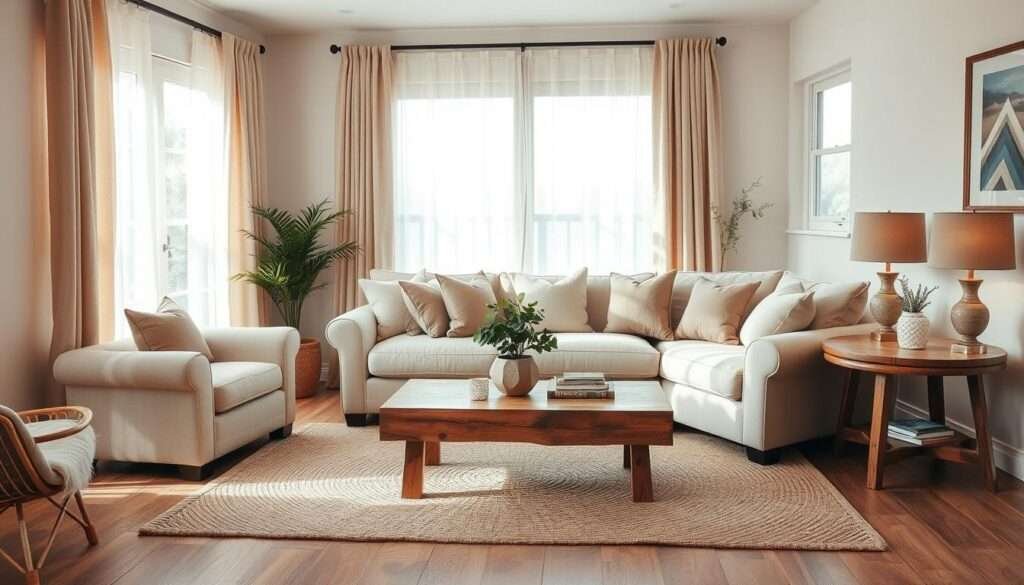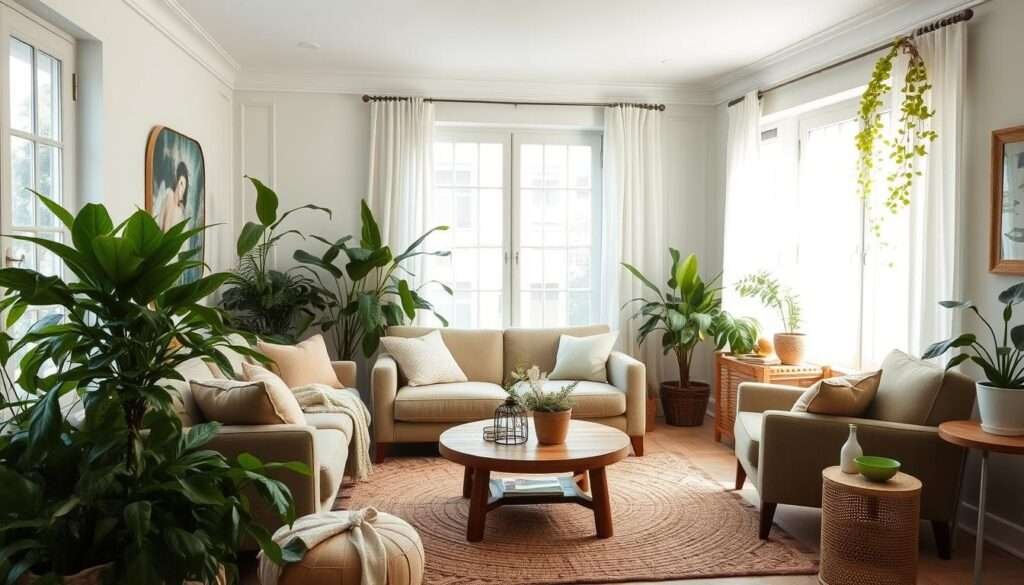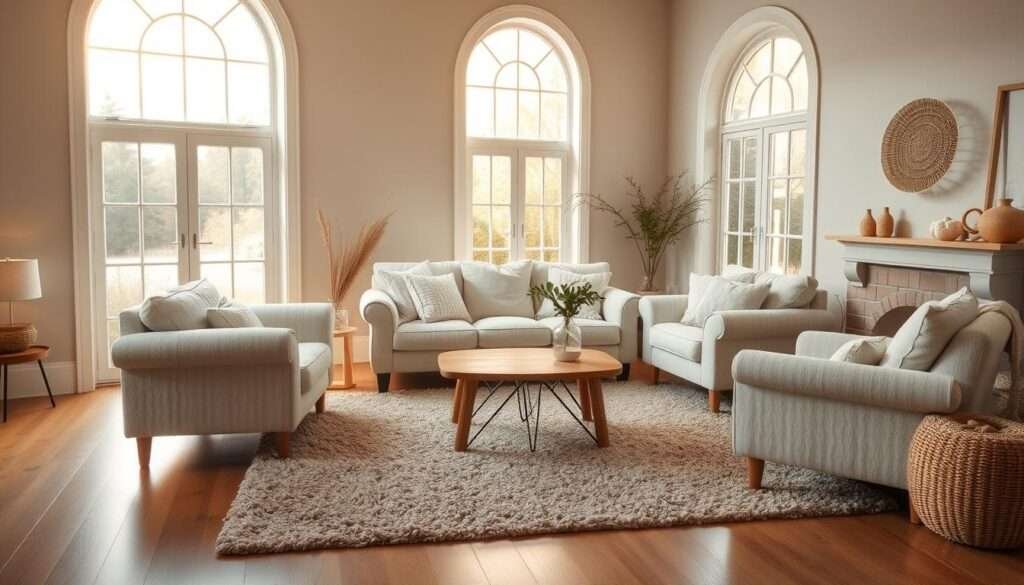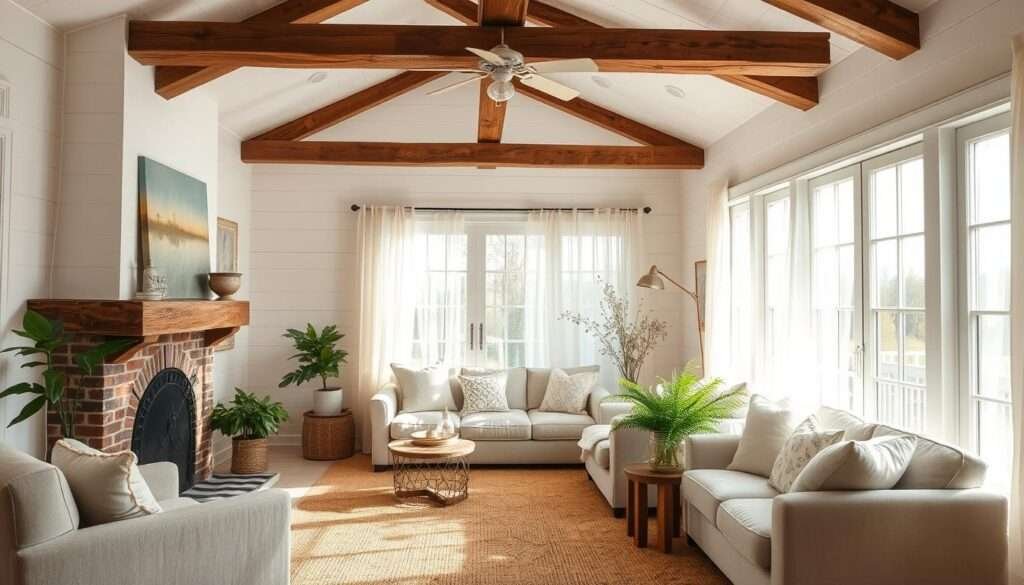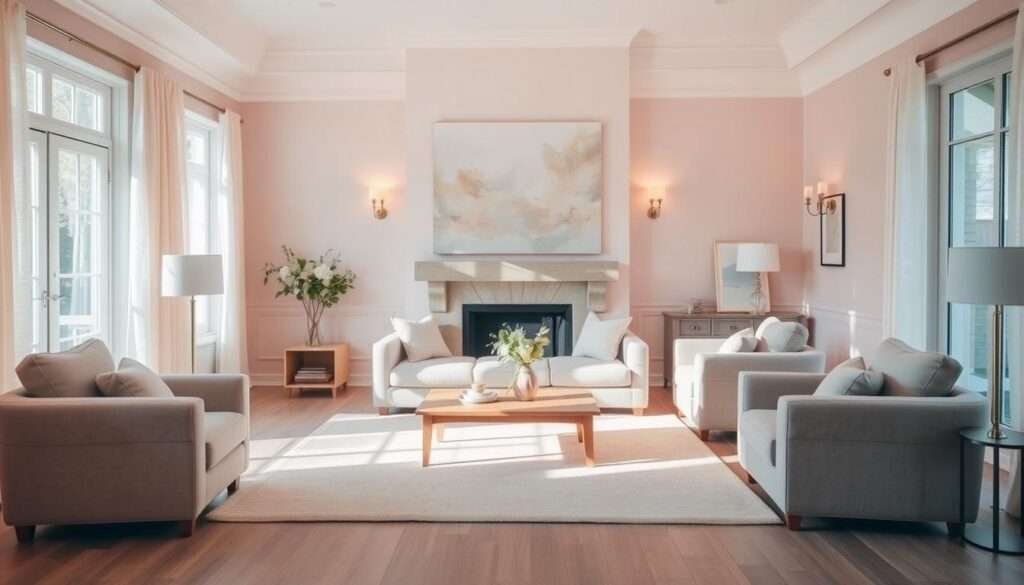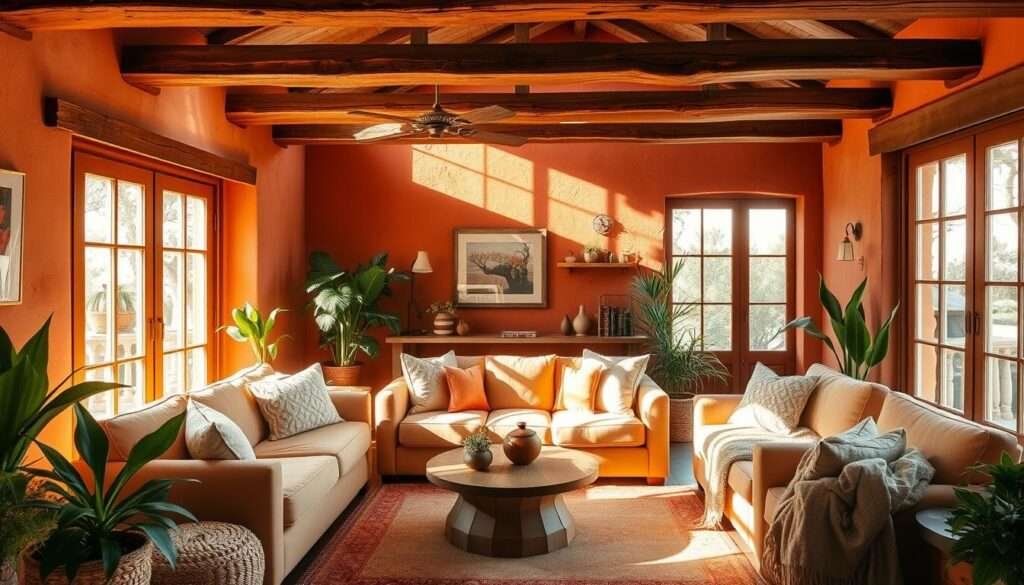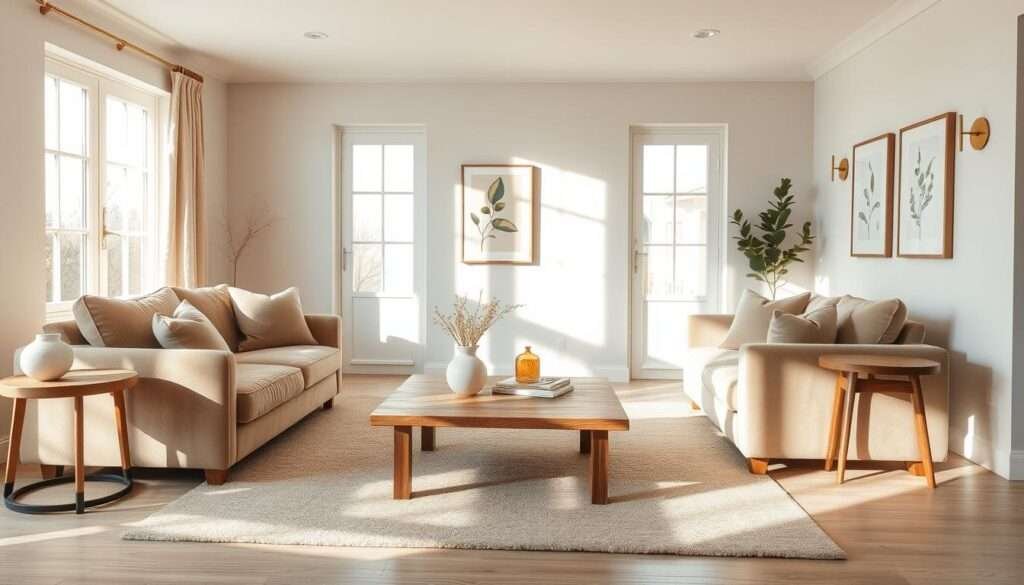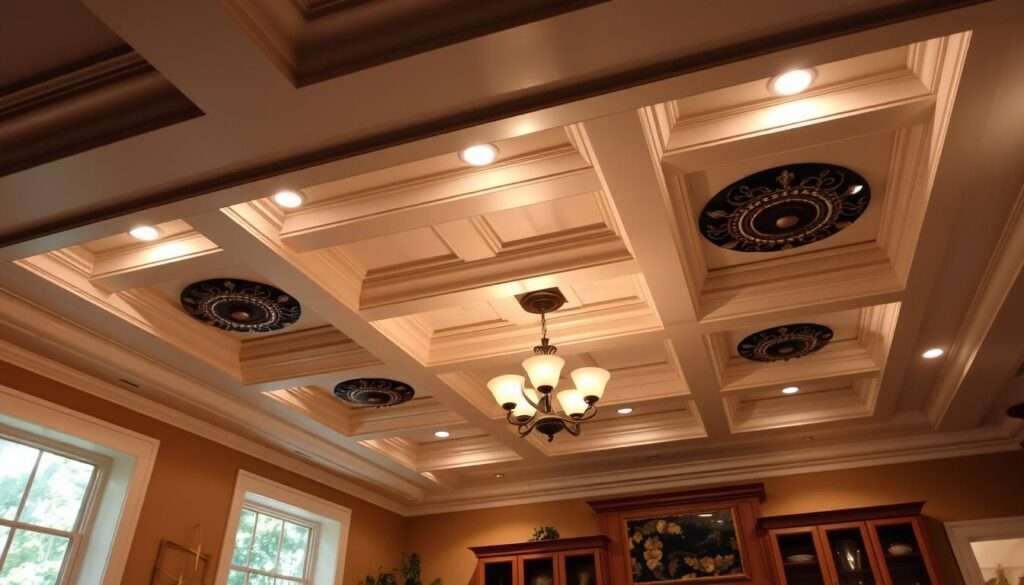Table of Contents
ToggleI still remember the first time I stood in my living room and felt the air change after a fresh coat of paint. I wanted a room feel that hugged me, whether I was reading at dusk or hosting friends on a bright afternoon. That search for mood led me to test swatches at different times of day and learn what truly makes a space sing.
I wrote this guide to help you pick a design direction with confidence. I’ll show how paint choices—from soft blues and earthy neutrals to dark teal—shape the look and warmth of a living room. You’ll get quick mini tables for paints and trim, plus decor lists for sofas, rugs, lighting, and art to make upgrades simple.
Expect practical tips on sampling, finishes like eggshell or satin, and using the 60-30-10 rule so your rooms feel balanced and lasting. By the end, you’ll have a clear plan and a short shopping list to start the change.
Key Takeaways
- Decide the mood first—relaxed, modern, or warm—and let that guide paint choices.
- Test swatches on multiple walls and observe them across the day.
- Use the 60-30-10 rule to balance major, secondary, and accent hues.
- Pick finishes based on light and traffic: matte, eggshell, or satin.
- Follow curated decor lists to tie paint, furniture, and textiles together.
Set the Mood: How Light, Layout, and Finish Shape a Cozy Color Palette
The mood of a space reveals itself as light moves—so I let that lead my palette choices. I start by reading the room at three checkpoints: morning, midday, and evening. This shows how natural light shifts paint and textiles across the day.
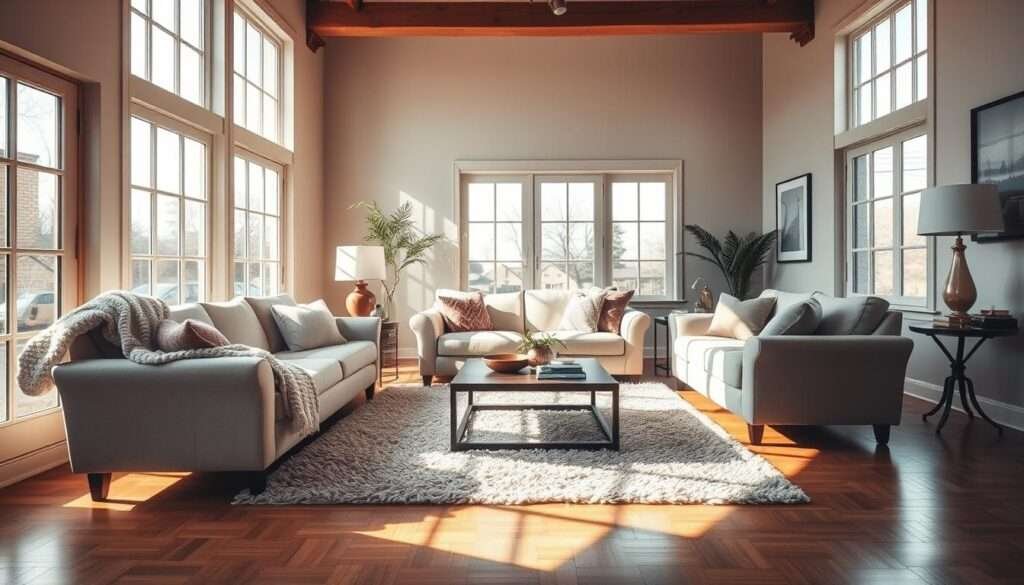
Pro tip: Read your natural light before picking paint
I test 3–5 contenders as large swatches on different walls and near key elements like a sofa or rug. South- and west-facing spaces can handle deeper hues; north-facing areas often benefit from warm tones so they don’t feel flat.
Finish matters: Matte vs. eggshell vs. satin
Matte softens reflections in bright living rooms. Eggshell gives wipeable versatility. Satin or semigloss is great for trim and built-ins, while a flat ceiling hides flaws and calms a space.
- I recommend Aura Interior matte for rich depth.
- Use Regal Select Interior where scrubbability matters.
- Choose Advance Interior for crisp trim and cabinetry.
| Light Level | Traffic | Walls | Trim / Ceiling |
|---|---|---|---|
| High sun | Low | Matte (saturated OK) | Warm white flat / satin trim |
| Moderate | Medium | Eggshell | Satin trim / flat ceiling |
| Low / north-facing | High | Matte or warm light hues | Durable satin trim / flat ceiling |
Quick checklist: confirm light direction, test large swatches, pick finishes per surface, and photograph tests at different times to lock your color palette.
Earthy Neutrals with Soul: Warm Whites, Beiges, and Taupes
A palette of beiges and taupes gives me a calm canvas to layer texture and light. I build schemes that let textiles and wood tell the story, so the space feels collected not matchy.
Image inspirations: Hygge textures with wood, linen, and woven accents
Image prompts: pale walls, linen sofa, rattan side table, warm wood coffee table, layered woven rugs and soft throws.
Mini table: Neutral wall paints + trim pairings + undertones
| Wall | Trim / Ceiling | Undertone Read |
|---|---|---|
| White Dove OC-17 | White Down 970 | Warm cream |
| Brandon Beige 977 | White Down 970 | Beige with soft depth |
| Wish AF-680 (greige) | White Down 970 | Balanced gray-beige |
Decor suggestions
Shopping list: velvet throw pillows, boucle poufs, rattan side tables, low-pile wool rug, woven baskets.
- Layer three textures on seating: linen, knit, velvet.
- Add one dark grounding piece—espresso or black metal.
- Echo wood tones in at least two spots to unite the area.
These elements keep neutral walls from feeling flat and help the living area feel warm and timeless.
Blue Serenity: Light Blues to Deep Oceans for a Calming Living Room
Blue palettes have a quiet power—I rely on them when I want a room to feel both calm and considered.
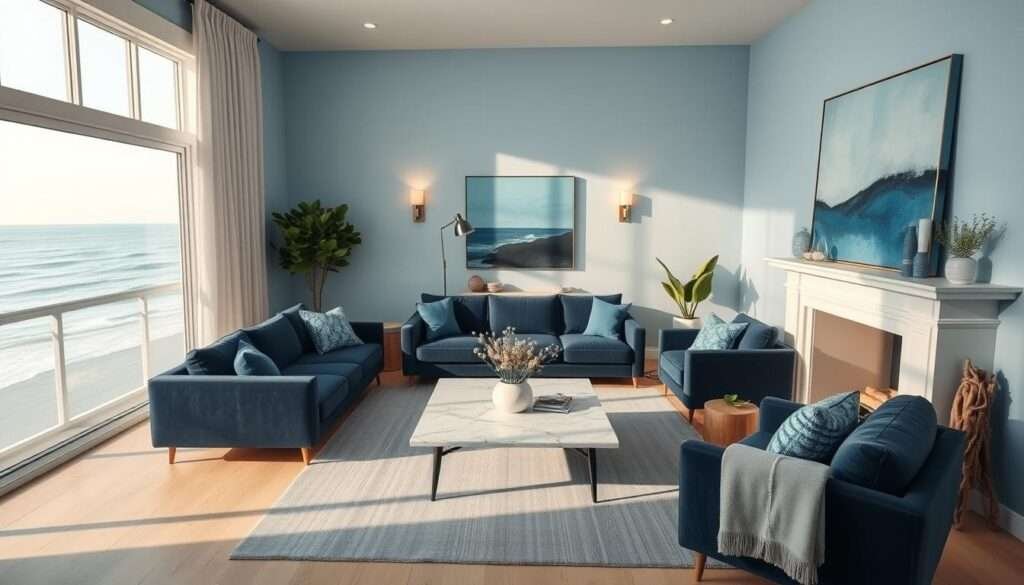
Layering tips: For an airy look, pair Gossamer Blue 2123-40 with crisp white trim and washed linen curtains. A natural jute or wool rug adds texture and warmth underfoot.
For moodier shades, try Twilight 2058-10 or Champion Cobalt 2061-20 on walls with a matte finish. Velvet seating and brushed brass lamps warm cooler tones and make evenings feel intimate.
Textiles that soften blue schemes
| Material | Why it works | Placement |
|---|---|---|
| Chunky knit | Adds tactile warmth | Throws on sofa |
| Chenille | Plush, low-sheen texture | Accent pillows |
| Washed linen | Airy, lived-in look | Curtains, pillow covers |
Decor accents and lighting ideas
- Brushed brass or antique brass lamps to introduce warm metallic glow.
- Natural wood stools and a whitewash coffee table to keep the palette grounded.
- One or two patterned throw pillows—small stripes or soft botanicals—for gentle movement.
- Layered lighting: overhead, table lamps, and candles so blues read well at night.
Sampling note: Test blues next to existing flooring and upholstery. Some shades lean yellow and feel warmer; others skew gray and read more muted under north light.
Classic Black and White with a Warm Twist
Pairing deep blacks with honeyed wood and brass is my go-to trick for a dramatic yet inviting room. I favor a single black wall or painted built-ins to anchor the space, then soften the scene with warm whites and tactile neutrals.
Style moves I use:
- Anchor a wall in Raccoon Fur 2126-20 or paint a media unit for instant drama.
- Add brass sconces, a slim floor lamp, and picture frames to bounce light.
- Introduce a warm wood console or coffee table to add organic richness.
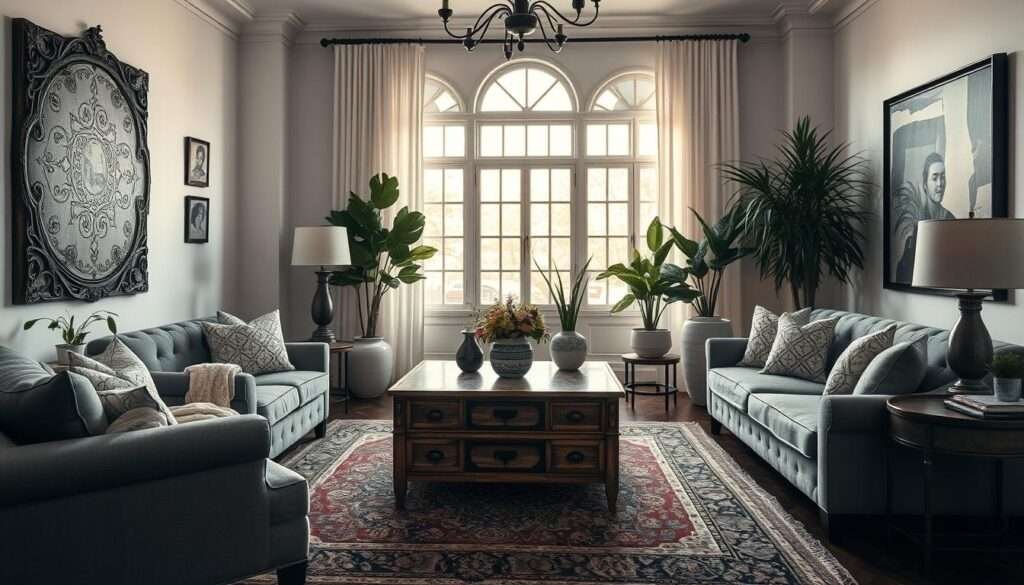
| Soft Whites | Blackened Grays | Undertone / Sheen |
|---|---|---|
| Warm White (eggshell) | Raccoon Fur 2126-20 (matte) | Warm vs cool; matte for velvety depth |
| Ivory Trim (satin) | Blackened Gray (eggshell) | Eggshell shows texture; satin for trim |
| Cream Ceiling (flat) | Charcoal Accent (matte) | Flat ceilings hide flaws; test samples |
Styling tip: Use graphic art in black ink on natural paper, a chunky knit throw, and a bouclé chair to layer texture. Repeat brass in at least three moments and echo wood once more for visual rhythm. Always sample paint near windows—undertones shift with light and change the final look.
Greens and Sage Surroundings: Nature’s Most Popular Living Room Hue
Green hues have a way of making a room feel rooted and quietly alive. I lean on sage to set a calm mood, then layer creams, oak, and natural textiles to keep the space airy and inviting.
Palette builder: Sage, olive, and moss with cream and oak
My simple starter is Sage + Cream + Oak. I often test October Mist 1495 for subtle softness and Fairmont Green HC-127 when I want a classic herbal tone.
| Green | Pairing | Undertone note |
|---|---|---|
| Sage (October Mist 1495) | Cream trim + Oak furniture | Soft, slightly gray — warms in west light |
| Olive (Fairmont Green) | Warm white + Brass accents | Earthy — reads richer in bright rooms |
| Moss | Natural linen + Black accents | Deep, grounding — use sparingly in north-facing rooms |
Plant styling: High/low greenery to amplify the biophilic feel
I layer plants at three heights to make a living vignette. A tall fiddle-leaf fig or olive tree becomes the hero in a corner.
- Medium: potted ferns or pothos on consoles.
- Small: succulents and trailing plants on shelves.
- Containers: terracotta planters, woven plant baskets, and rattan pots tie the look together.
Furnishings in linen, cane, and oak anchor the scheme. Add botanical art, ceramic lamps with textured shades, and a wool rug to keep the living area warm and layered.
For north-facing rooms choose warmer greens or cream trim so the space stays cozy. In bright rooms, deeper olive or moss adds depth without heaviness.
Warm Whites that Glow: Scandinavian-Inspired Comfort
A pale, warm white helps wood and textiles take center stage while the walls stay calm.
I build a Scandinavian-inspired scheme around plush pillows, thick blankets, pale oak furniture, and warm-white paint so the living room reads soft and collected rather than stark.
I recommend White Dove OC-17 on walls, a brighter white for the ceiling, and pale oak or ash pieces to add gentle contrast. A washable slipcovered sofa keeps the look practical for family life.
- Layer chunky knit throws, a sheepskin on a chair, and a pale wool rug for texture.
- Test whites side-by-side to catch creamy vs. gray undertones, especially in low winter light.
- Use three lamps at varied heights so warm whites glow and the room avoids flatness.
| Paint | Undertone | Best use |
|---|---|---|
| White Dove OC-17 | Soft warm cream | Walls |
| Alabaster | Neutral-warm | Ceiling or trim |
| Simply White | Brighter, higher LRV | Bright rooms / contrast |
Styling note: Add a single black lamp base or frame to sharpen the look. Favor tactile ceramics and unfinished wood trays, and let texture — not saturated color — give depth to the space.
Cozy Cottagecore and Modern Farmhouse Whites
I favor soft whites and layered textiles when I want a space to feel collected and welcoming. A shiplap feature or painted boards give the living room instant personality without heavy color.
Shiplap, soft white paints, and mix-and-match textiles
Style move: start with warm white walls or shiplap, then add striped ticking, small florals, and knitted throws for a relaxed, mixed look.
Decor mix and styling tips
- Woven baskets, vintage books, and floral art prints for collected charm.
- Introduce wood furniture—a rustic bench or coffee table—to add organic warmth.
- Use a patterned flat-weave rug for subtle interest and durability in high-traffic areas.
- Choose simple black or brass hardware and paint built-ins in soft white satin for wipeable sheen.
| Paint | Warmth | LRV |
|---|---|---|
| Antique White | Warm cream | 82 |
| Soft Linen | Neutral-warm | 78 |
| Cottage White | Gentle warm | 85 |
Quick idea: layer books, pottery, and a few stems; swap pillows seasonally to refresh the look without a full repaint.
Gentle Pastels and Blush: Soft Color That Still Feels Grown-Up
Pastels can feel elegant if you anchor them with warm whites and clean lines. I use blush as an accent, not the main field, so the scheme reads sophisticated and modern.
Balance guide: where each tone belongs
Strategy: pair cream upholstery and warm white walls with small blush moments and muted blue accents. Keep furniture lines simple so pastels stay grown-up.
| Element | Suggested Hue | Placement |
|---|---|---|
| Warm white | Backdrop | Walls, ceiling |
| Cream | Soft neutral | Upholstery |
| Blush | Pale pink | Accent ottoman, art, throw pillows |
| Muted blue | Desaturated | Pillows, small rug |
Style notes and sampling steps
- Test cool vs. peachy blush next to cream fabrics before you buy paint.
- Add texture: linen drapery, boucle pillows, and a neutral wool rug.
- Include one brushed-gold lamp or frame to lift the palette.
- Rotate throw pillows seasonally to shift tone with little effort.
Peach, Terracotta, and Rustic Reds for Sun-Warmed Comfort
Sun-warmed peaches and terracotta tones bring a soft, baked glow that makes a room feel settled and sunlit. I use these hues when I want the living area to feel like late afternoon light, even on gray days.
Try a muted terracotta accent wall or a painted fireplace surround paired with off-white walls and natural wood furniture. Rustic reds can act like a near-neutral when balanced with creams and oak, adding depth without overpowering the space.
Image prompts
- Terracotta planters with olive trees on a hearth or console.
- Kilim pillows on a linen sofa and a woven area rug with warm neutrals.
- Earthenware lamps with warm linen shades and a reclaimed wood coffee table.
| Hue | Trim / Use | Best for |
|---|---|---|
| Peachy Neutral | Soft off-white trim | Full wall or ceiling-adjacent walls |
| Sunbaked Terracotta | Warm white or cream trim | Accent wall or fireplace surround |
| Russet Red | Bronze/wood accents | Focal point, built-in, or cabinetry |
Decor checklist
- Anchor the area with a warm-patterned rug that ties peaches and rusts together.
- Add brass or bronze accents to echo warmth and avoid too much orange.
- Choose art with desert or landscape tones and a reclaimed wood coffee table for authenticity.
- Layer linen, leather, and wool textiles for tactile depth and comfort.
Dark Teal and Jewel Tones: Cocooning Drama Done Right
Deep jewel tones can fold a room into a warm, private retreat when treated like a backdrop for texture and light. I use rich paints — Gentleman’s Gray 2062-20, Tucson Teal 2056-10, or Pacific Rim 678 — to set the mood, then balance them with layered lighting and tactile furnishings.
Lighting layers that make deep hues feel intimate, not cave-like
I design a plan with a dimmable pendant, two table lamps with warm bulbs, and a floor lamp to lift corners. Small sconces or candle clusters near a fireplace create soft focal points so the space reads luxurious and inviting rather than dark.
Cozy materials: Velvet sofas, wool area rugs, smoked glass
A velvet sofa in emerald or garnet, wool rug underfoot, and smoked glass lamps add depth without high gloss. Jewel-tone throw pillows and a brass-accented coffee table warm the palette and give small hits of light.
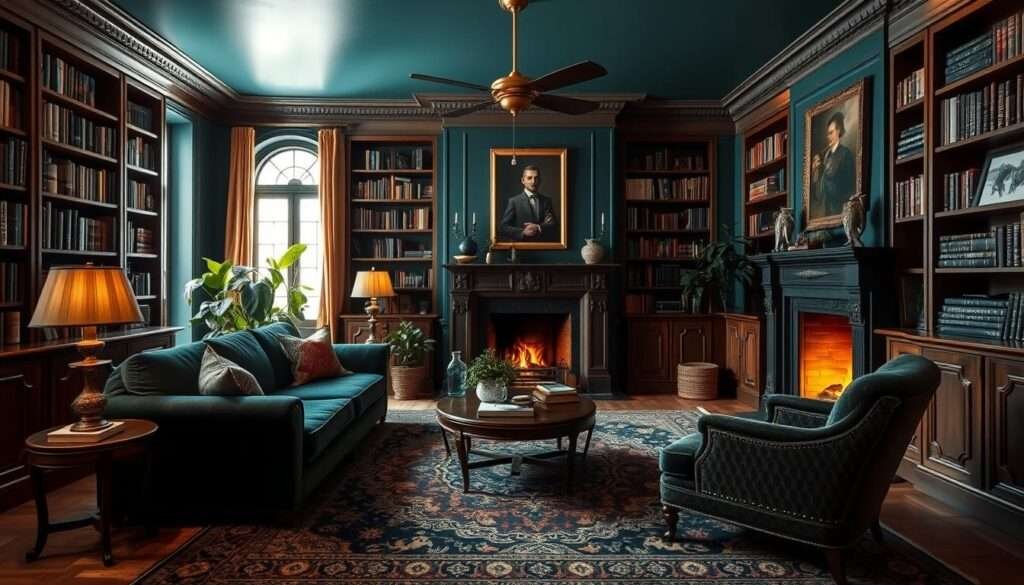
| Material | Why it works | Use |
|---|---|---|
| Velvet | Plush depth | Sofa, pillows |
| Wool | Soft underfoot | Area rug |
| Smoked glass | Reflective depth | Lamps, side tables |
| Brushed brass | Warm highlights | Hardware, table base |
Quick tips: keep at least one light or pale rug so the room breathes. Test deep shades in both day and at night — jewel tones shift dramatically under warm bulbs. For more textured, cottage-minded ideas see this cozy kitchen link: cottage kitchen ideas.
Greige and Balanced Neutrals for Effortless Modern Living
I often choose greige when I want a neutral base that reads fresh in every season. Greige blends warm and cool tones so a living room feels modern and relaxed without fuss.
Greige simplifies decisions: a single palette connects open-plan rooms, lets art and greenery pop, and works with many furniture finishes. I aim for walls slightly deeper than trim to add quiet architecture and depth.
| Paint | Undertone | Best use |
|---|---|---|
| Revere Pewter HC-172 | Soft green-gray | Walls in open-plan living |
| Classic Gray OC-23 | Subtle violet-gray | Trim or lighter walls |
| Greige Neutral (custom) | Warm taupe-gray | Accent wall or built-ins |
Decor checklist:
- Tailored sofa in performance fabric for daily use.
- Low-profile wool or wool-blend rug to anchor the seating area.
- Mix of black metal and oak furnishings for calm contrast.
- One accent material—travertine, boucle, or ribbed glass—for subtle interest.
I arrange furniture to preserve flow in open-plan layouts, using a rug and low console to anchor the living zone. Small seasonal swaps—pillows, throws, and a vase—keep the feel fresh across rooms.
Cozy Living Room Color Schemes That Transform Your Home
I begin by mapping the biggest areas and then plan small hits of color to guide the eye. This simple ratio keeps a living area balanced and easy to style.
How the rule works
The rule: 60% dominant (walls, large rug), 30% secondary (sofa, curtains), 10% accent (pillows, art, decor). Pick the dominant in a calm shade, use richer secondary tones, and reserve saturated accents for energy.
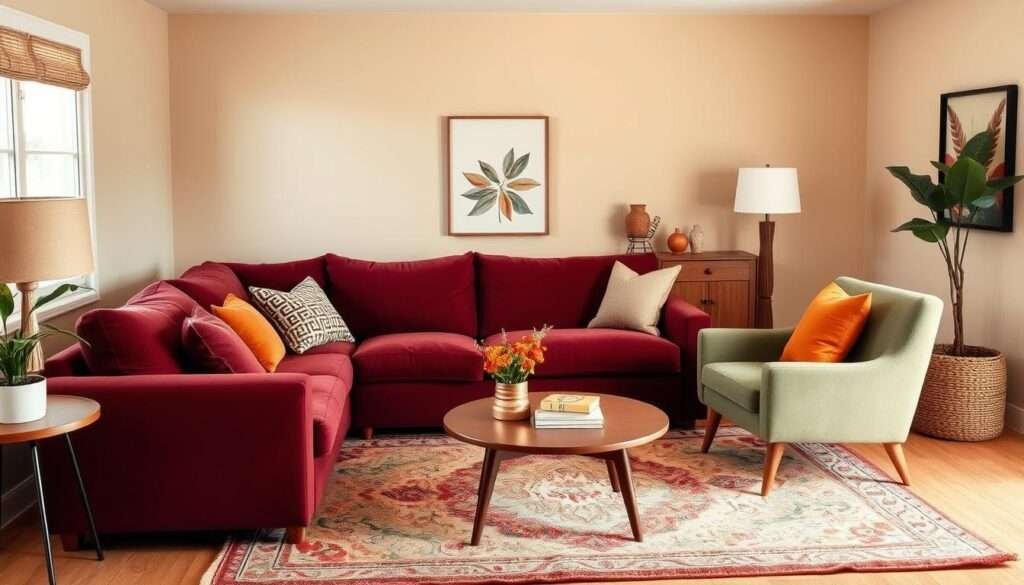
Quick reference: Dominant / Secondary / Accent examples
| Palette | Dominant (Walls / Big Rug) | Secondary (Sofa / Chairs) | Accent (Pillows / Art / Decor) |
|---|---|---|---|
| Neutrals | Warm white or greige | Beige linen or taupe sofa | Dark trim, black frame, textured throws |
| Blue | Soft sky blue walls | Denim or slate sofa | Brushed brass lamps, patterned pillows |
| Green | Sage or muted olive | Natural linen seating | Terracotta pots, botanical art |
| Warm / Terracotta | Soft peach or clay wall | Warm wood furniture | Russet pillows, earthenware accents |
Practical tips and checklist
- Echo one accent hue across pillows, art, and a small vase so the design reads intentional.
- If you keep an existing sofa or rug, let it dictate the dominant or secondary role.
- For an accent wall, paint the remaining walls a lighter, related neutral to preserve airiness.
- Monochrome? Vary depth and sheen—matte walls, satin trim, glossy accessories—to create contrast.
- Sample paints on large boards and view them in morning, midday, and evening light before you commit.
- Final checklist: choose dominant, pick secondary, add 10% accent, sample, photograph, and adjust.
Ceilings, Trim, and Fireplaces as Focal Points
Giving the ceiling a soft tint is one of my fastest tricks to redraw a room’s mood. A painted overhead plane can make a living area feel taller, warmer, or calmer depending on shade and finish.
Painted ceilings:
Soft gray, taupe, or sky to change the atmosphere
I favor matte finishes on ceilings to hide imperfections and create a gentle glow. Dolphin AF-715 or Chelsea Gray HC-168 add modern punch without stealing the show.
Fireplace refresh: saturated accent, warm white, or stone-friendly hues
A fireplace makes a strong statement point. Use a saturated hue for drama, warm white for a fresh reset, or a stone-friendly tone to complement masonry.
| Ceiling Hue | Matching Wall | Undertone |
|---|---|---|
| Soft Sky | Warm White | Cool blue |
| Taupe | Greige | Warm brown |
| Light Gray | Muted Neutral | Soft gray |
- Products: Aura Interior for depth, Regal Select for durability, Advance Interior for trim and fireplace surrounds.
- Add dimmers and layered lighting so the ceiling and fireplace read well in day and night.
- Weekend plan: tape, prime, paint ceiling and mantel, swap hardware, and step back to test the look.
Monochrome and Color Drenching for a Cozy, Immersive Feel
I love how a single hue can wrap a space into a deliberate atmosphere. When done well, drenching creates an enveloping, intentional living area where walls, trim, and built-ins read as one quiet canvas.
How to shift tones on walls, trim, and built-ins for depth
Strategy: use three related tones from the same family to avoid flatness. Paint walls in a medium depth, trim one shade deeper or a glossier sheen, and keep built-ins a touch lighter to add subtle contrast.
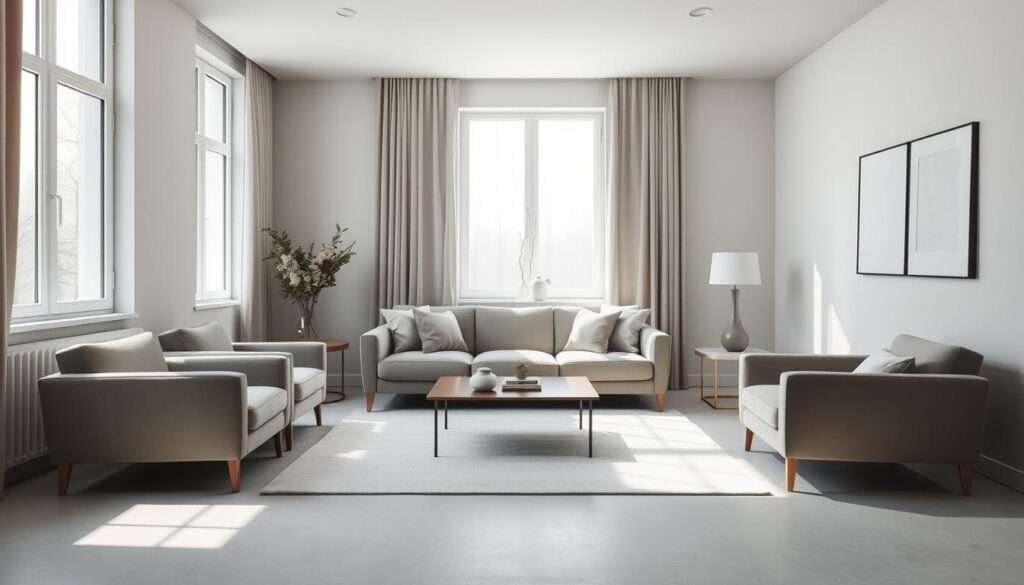
I suggest these image prompts: muted sage for a serene look, warm taupe for soft neutrality, or smoky blue for moody calm. Pair the drench with tactile pieces—bouclé chair, ribbed glass lamp, and a wool rug—so texture reads as design, not rescue.
| Element | Tonal Role | Finish Suggestion |
|---|---|---|
| Walls | Base / medium depth | Matte for atmosphere |
| Trim | Deeper or glossier | Satin for crisp lines |
| Built-ins | Lighter shade | Eggshell for subtle sheen |
- Sample three adjacent shades on one wall to map undertones.
- Choose matte walls + satin trim to keep detail and warmth.
- In small rooms, drenching blurs boundaries and can feel larger.
- Use substantial mats and slim frames for art so pieces whisper contrast.
- Keep touch-up paint in the same sheen for easy maintenance.
Quick checklist: align undertones across all painted elements, test finishes in morning and evening light, and balance the monochrome with layered textures. For more examples of full-room drenching, see this guide on bold applications: color-drenching ideas.
Maximalist Energy vs. Minimalist Calm: Styling to Match Your Color Story
A strong focal point helps me commit: gallery drama or a calm, tactile coffee table vignette.
I help you match styling to the palette you picked so the area reads intentional. Pick maximalist when you want expression and motion. Choose minimalist when you want clarity and rest.
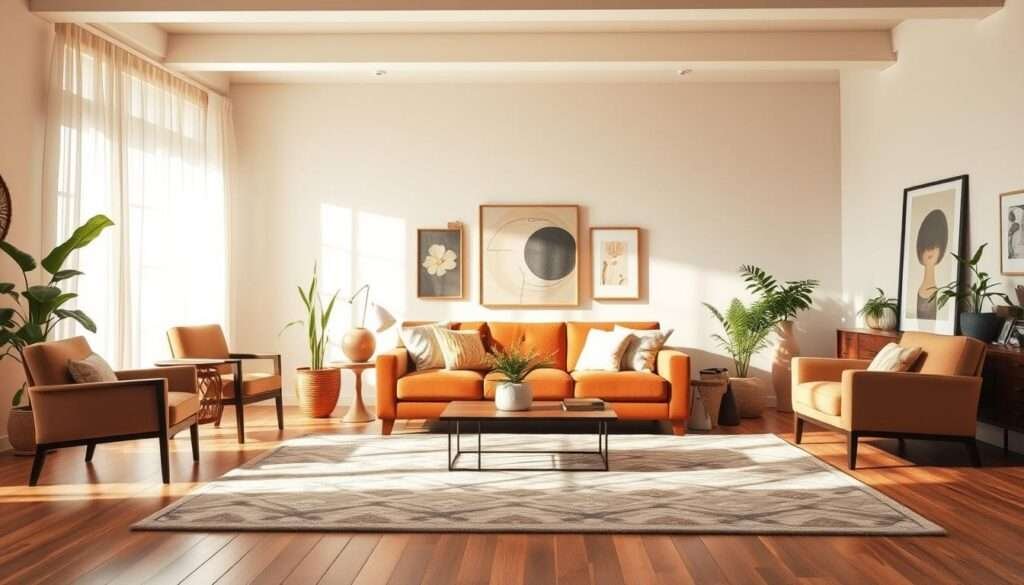
Maximalist checklist
- Gallery wall: mix frame sizes, layer matting, and balance symmetry with a salon grouping.
- Patterned textiles: combine scale — large rug motifs, mid-scale pillows, and small-scale trim.
- Collected decor: display ceramics, books, and travel finds across shelving and a statement coffee table.
- Lighting: layer pendants, table lamps, and decorative sconces to read like jewelry in the room.
Minimalist checklist
- Natural light: prioritize windows and sheer treatments to keep the area bright and open.
- Texture layers: use a tactile rug, sculptural pillow, and linen drape instead of pattern.
- Negative space: edit furniture and art so each piece has breathing room and purpose.
- Lighting: choose two refined fixtures and a dimmer to unite function and mood.
| Color Intensity | Pattern Scale | Art Density / Negative Space |
|---|---|---|
| High saturation | Large, bold patterns | Dense gallery or statement art |
| Medium | Mixed scales for balance | One strong wall moment + edited shelves |
| Muted / neutral | Minimal pattern, focus on material | Generous negative space, single sculptural piece |
Quick styling tips: curate furniture so each item earns its spot—fewer, better pieces for calm; an expressive mix for energy. Use a coffee table vignette or a gallery wall as your anchor and let lighting and rug tie the plan together.
Bring It Home: My Favorite Decor Pairings, Image Ideas, and Room-Ready Palettes
Here are five room-ready palettes and simple moves that make finishing a living area feel reachable.
I list mini pairings—Warm White + Linen + Oak; Sky Blue + Crisp White + Brass; Sage + Cream + Oak; Dark Teal + Brass + Ivory; Black & White + Wood + Gold—along with image prompts and a short decor checklist for each.
Quick-start shopping: pick one anchor (sofa or rug), add two lamps, three pillow styles, and one statement art piece. Use matte walls for an envelope and satin trim for crisp edges.
Small upgrades—paint the fireplace surround, refresh the ceiling, swap hardware to aged brass—add instant warmth. Keep touch-up paint labeled, use performance fabrics, and snap photos of samples as you finalize the look.

